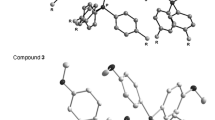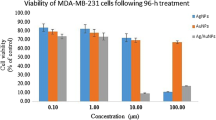Abstract
Breast cancer represents the second cause of death in the European female population. The lack of specific therapies together with its high invasive potential are the major problems associated to such a tumor. In the last three decades platinum-based drugs have been considered essential constituents of many therapeutic strategies, even though with side effects and frequent generation of drug resistance. These drugs have been the guide for the research, in last years, of novel platinum and ruthenium based compounds, able to overcome these limitations. In this work, ruthenium and platinum based phthalocyanines were synthesized through conventional techniques and their antiproliferative and/or cytotoxic actions were tested. Normal mammary gland (MCF10A) and several models of mammarian carcinoma at different degrees of invasiveness (BT474, MCF-7 and MDA-MB-231) were used. Cells were treated with different concentrations (5–100 μM) of the above reported compounds, to evaluate toxic concentration and to underline possible dose–response effects. The study included growth curves made by trypan blue exclusion test and scratch assay to study cellular motility and its possible negative modulation by phthalocyanine. Moreover, we investigated cell cycle and apoptosis through flow cytometry and AMNIS Image Stream cytometer. Among all the tested drugs, tetrasulfonated phthalocyanine of platinum resulted to be the molecule with the best cytostatic action on neoplastic cell lines at the concentration of 30 μM. Interestingly, platinum tetrasulfophtalocyanine, at low doses, had no antiproliferative effects on normal cells. Therefore, such platinum complex, appears to be a promising drug for mammarian carcinoma treatment.











Similar content being viewed by others
Abbreviations
- ICP MS:
-
Inductively-coupled-plasma mass-spectrometry
- DMEM:
-
Dulbecco’s modified Eagle medium
- PcS:
-
Tetrasulfophthalocyanina
- PtPcS:
-
Platinum (II) tetrasulfonated phthalocyanine
- PtPcC:
-
Platinum (II) tetracarboxylated phthalocyanine
- RuPcS:
-
Ruthenium (II) tetrasulfonated phthalocyanine
- RuPcC:
-
Ruthenium (II) tetracarboxylated phthalocyanine
- RuPcAlkC:
-
β-Tetrapentylcarboxylated ruthenium (II) phthalocyanine
- RPMI:
-
Roswell Park Memorial Institute
- DMEM/F12:
-
Dulbecco’s modified Eagle medium: Nutrient mixture F-12
- PI:
-
Propidium iodide
References
Alessio E, Mestroni G, Nardin G, Attia WM, Calligaris M, Sava G, Zorzet S (1988) Cis- and trans-dihalotetrakis(dimethyl sulfoxide)ruthenium(II) complexes (RuX2(DMSO)4; X = Cl, Br): synthesis, and antitumor activity. Inorg Chem 27:4099–4106
Ali A, van Lier JE (1999) Metal complexes as photo- and radiosensitizers. Chem Rev 99:2379–2450
Aliwaini S, Swarts JA, Blanckenberg A, Mapolie S, Prince S (2013) A novel binuclear palladacycle complex inhibits melanoma growth in vitro and in vivo through apoptosis and autophagy. Biochem Pharmacol 86:1650–1663
Allardyce CS, Dyson PJ (2006) Medicinal properties of organometallic compounds. Top Organomet Chem 17:177–210
Allison RR, Sibata CH (2010) Oncologic photodynamic therapy photosensitizers: a clinical review. Photodiagn Photodyn Ther 7:61–75
Anderson CM, Taylor IR, Tibbetts MF, Philpott J, Hu Y, Tanski JM (2012) Hetero-multinuclear ruthenium(III)/platinum(II) complexes that potentially exhibit both antimetastatic and antineoplastic properties. Inorg Chem 51:12917–12924
Ang WH, Casini A, Sava G, Dyson PJ (2011) Organometallic ruthenium-based antitumor compounds with novel modes of action. J Organomet Chem 696:989–998
Arnesano F, Losacco M, Natile G (2013) An update view of cisplatin transport. Eur J Inorg Chem 2013:2701–2711
Bertagnolo V, Benedusi M, Brugnoli F, Lanuti P, Marchisio M, Querzoli P, Capitani S (2007) Phospholipase C-β2 promotes mitosis and migration of human breast cancer-derived cells. Carcinogenesis 28:1638–1645
Biersack B, Schobert R (2013) Platinum and ruthenium complexes for the therapy of breast cancer diseases, chap. 16. In: Ahmad A (ed) Breast cancer metastasis and drug resistance: progress and prospect, Springer, New York, pp 275–290
Camerlingo R, Franco R, Tirino V, Cantile M, Rocchi M, La Rocca A, Martucci N, Botti G, Rocco G, Pirozzi G (2011) Establishment and phenotypic characterization of the first human pulmonary blastoma cell line. Lung Cancer 72:23–31
Carchesio M, Tonucci L, d’Alessandro N, Morvillo A, Del Boccio P, Bressan M (2010) Visible photostability of some ruthenium and platinum phthalocyanines in water and in the presence of organic substrates. J Porphyr Phthalocyanines 14:499–508
Choy H, Park C, Yao M (2008) Current status and future prospects for satraplatin, an oral platinum analogue. Clin Cancer Res 14:1633–1638
Clarke MJ, Zhu F, Frasca DR (1999) Non-platinum chemotherapeutic metallopharmaceuticals. Chem Rev 99:2511–2533
D’Ambrosio P, Tonucci L, d’Alessandro N, Morvillo A, Sortino S, Bressan M (2011) Water-soluble transition-metal-phthalocyanines as singlet oxygen photosensitizers in ene reactions. Eur J Inorg Chem 4:503–509
d’Alessandro N, Tonucci L, Morvillo A, Dragani LK, Di Deo M, Bressan M (2005) Thermal stability and photostability of water solutions of sulfophthalocyanines of Ru(II), Cu(II), Ni(II), Fe(III) and Co(II). J Organomet Chem 690:2133–2141
Dwyer FP, Gyarfas EC, Rogers WP, Koch JH (1952) Biological activity of complex ions. Nature 170:190–191
Edrei R, Gottfried V, van Lier JE, Kimel S (1998) Sulfonated phthalocyanines: photophysical properties, in vitro cell uptake and structure-activity relationships. J Porphyr Phthalocyanines 2:191–199
Entschladen F, Bastian P, Niggemann B, Zaenker KS, Lang K (2004) Inhibition of cell migration via G protein-coupled receptors to opioid peptides and angiotensin. Ann N Y Acad Sci 1028:320–328
Erba E, Bergamaschi D, Bassano L, Damia G, Ronzoni S, Faircloth GT, D’Incalci M (2001) Ecteinascidin-743 (ET-743), a natural marine compound, with a unique mechanism of action. Eur J Cancer 37:97–105
Gianferrara T, Bratsos I, Alessio E (2009) A categorization of metal anticancer compounds based on their mode of action. Dalton Trans 37:7588–7598
Godwin AK, Meister A, O’Dwyer PJ, Huang CS, Hamilton TC, Anderson ME (1992) High resistance to cisplatin in human ovarian cancer cell lines is associated with marked increase of glutathione synthesis. Proc Natl Acad Sci USA 89:3070–3074
Graf N, Lippard SJ (2012) Redox activation of metal-based prodrugs as a strategy for drug delivery. Adv Drug Deliv Rev 64:903–1004
Hall MD, Mellor HR, Callaghan R, Hambley TW (2007) Basis for design and development of platinum(IV) anticancer complexes. J Med Chem 50:3403–3411
Ishii K (2012) Functional singlet oxygen generators based on phthalocyanines. Coord Chem Rev 256:1556–1568
Komeda S, Casini A (2012) Next-generation anticancer metallodrugs. Curr Top Med Chem 12:219–235
Lanuti P, Marchisio M, Cantilena S, Paludi M, Bascelli A, Gaspari AR, Grifone G, Centurione MA, Papa S, Di Pietro R, Cataldi A, Miscia S, Bertagnolo V (2006) A flow cytometry procedure for simultaneous characterization of cell DNA content and expression of intracellular protein kinase C-ζ. J Immunol Methods 315:37–48
Lanuti P, Bertagnolo V, Pierdomenico L, Bascelli A, Santavenere E, Alinari L, Capitani S, Miscia S, Marchisio M (2009a) Enhancement of TRAIL cytotoxicity by AG-490 in human ALL cells is characterized by downregulation of cIAP-1 and cIAP-2 through inhibition of Jak2/Stat3. Cell Res 19:1079–1089
Lanuti P, Fuhrmann S, Lachmann R, Marchisio M, Miscia S, Kern F (2009b) Simultaneous characterization of phospho-proteins and cell cycle in activated T cell subsets. Int J Immunopathol Pharmacol 22:689–698
Lebwohl D, Canetta R (1998) Clinical development of platinum complexes in cancer therapy: an historical perspective and an update. Eur J Cancer 34:1522–1534
Lessa JA, Soares MA, dos Santos RG, Mendes IC, Salum LB, Daghestani HN, Andricopulo AD, Day BW, Vogt A, Beraldo H (2013) Gallium(III) complexes with 2-acetylpyridine-derived thiosemicarbazones: antimicrobial and cytotoxic effects and investigation on the interactions with tubulin. Biometals 26:151–165
Leznoff CC, Lever ABP (1996) Phthalocyanines: properties and applications, vol 4. Wiley, Weiheim
Liang CC, Park AY, Guan JL (2007) In vitro scratch assay: a convenient and inexpensive method for analysis of cell migration in vitro. Nat Protoc 2:329–333
Lipponer KG, Vogel E, Keppler BK (1996) Synthesis, characterization and solution chemistry of trans-indazoliumtetrachlorobis(indozole)ruthenate(III), a new anticancer ruthenium complex. IR, UV, NMR, HPLC investigations and antitumor activity. Crystal structures of trans-1-methyl-indazoliumtetrachlorobis-(1-methylindazole)ruthenate(III) and its hydrolysis product trans-monoaquatrichlorobis-(1-methylindazole)-ruthenate(Ill). Met Based Drugs 3:243–260
Lorico A, Rappa G (2011) Phenotypic heterogeneity of breast cancer stem cells. J Oncol 10:1155–1161
Meggers E (2007) Exploring biologically relevant chemical space with metal complexes. Curr Opin Chem Biol 11(2007):287–292
Mello LD, Ribeiro ES, Kubota LT, Elmroth SKC, Pereira RMS (2009) Electrochemical and spectroscopic evidences of the interaction between DNA and Pt(II)(dppf)-complex. Biometals 22:385–392
Merrin C (1976) A new method to prevent toxicity with high doses of cis diamine platinum (therapeutic efficacy in previously treated widespread and recurrent testicular tumors). Proc Am Soc Clin Oncol 17:243–246
Micouskova J, Kasparkova J, Suchankova T, Komeda S, Brabec V (2012) DNA conformation and repair of polymeric natural DNA damaged by antitumor azolato-bridged dinuclear PtII complex. J Inorg Biochem 114:15–23
Nicastro M, Tonucci L, d’Alessandro N, Bressan M, Dragani LK, Morvillo A (2007) Platinum tetrasulfophthalocyanine as selective catalyst for the aerobic oxidation of shikimic acid. Inorg Chem Commun 10:1304–1306
Prabhakaran P, Hassiotou F, Blancafort P, Filgueira L (2013) Cisplatin induces differentiation of breast cancer cells. Front Oncol 3:134
Rosenberg B, Van Camp L, Krigas T (1965) Inhibition of cell division in Escherichia coli by electrolysis products from a platinum electrode. Nature 205:698–699
Ryan JW, Anaya-Plaza E, de la Escosura A, Torres T, Palomares E (2012) Small molecule solar cells based on a series of water-soluble zinc phthalocyanine donors. Chem Commun 48:6094–6096
Sava G, Capozzi I, Clerici K, Gagliardi G, Alessio E, Mestroni G (1997) Pharmacological control of lung metastases of solid tumours by a novel ruthenium complex. Clin Exp Metastasis 16:371–379
Selvamurugan S, Ramachandran R, Viswanathamurthi P (2013) Ruthenium(II) carbonyl complexes containing S-methylisothiosemicarbazone based tetradentate ligand: synthesis, characterization and biological applications. Biometals 26:741–753
Sorokin AB, Kudrik EV (2011) Phthalocyanine metal complexes: versatile catalysts for selective oxidation and bleaching. Catal Today 159:37–56
Ting Chang T, More SV, Lu N, Jhuo JW, Chen YC, Jao SC, Li WS (2011) Polyfluorinated bipyridine cisplatins manipulate cytotoxicity through the induction of S-G2/M arrest and partial intercalation mechanism. Bioorg Med Chem 19:4887–4894
Valduga G, Bianco G, Csik G, Reddi E, Masiero L, Garbisa S, Jori G (1996) Interaction of hydro- or lipophilic phthalocyanines with cells of different metastatic potential. Biochem Pharmacol 51:585–590
Van Rijt SH, Sadler PJ (2009) Current applications and future potential for bioinorganic chemistry in the development of anticancer drugs. Drug Discov Today 14:1089–1097
Ward JM, Grabin ME, Berlin E, Young DM (1977) Prevention of renal failure in rats receiving cis-diamminedichloroplatinum(II) by administration of furosemide. Cancer Res 37:1238–1240
Weber JH, Bush DH (1965) Complexes derived from strong field ligands. XIX. Magnetic properties of transition metal derivatives of 4, 4′, 4″, 4″′-tetrasulfophthalocyanine. Inorg Chem 4:469–470
Wexselblatt E, Yavin E, Gibson D (2012) Cellular interactions of platinum drugs. Inorg Chim Acta 393:75–83
Wheate NJ, Walker S, Craig GE, Oun R (2010) The status of platinum anticancer drugs in the clinic and in clinical trials. Dalton Trans 39:8113–8127
Acknowledgments
The authors are grateful for financial support to the “Ministero dell’Università e della Ricerca” (MIUR) for PRIN Project: 2008F5A3AF_004, (Metal-phthalocyanines as potential antitumor drugs) and FIRB Project 2010. The present research was also supported by “Carichieti” foundation, Chieti, Italy.
Author information
Authors and Affiliations
Corresponding authors
Additional information
Giuseppina Bologna, Paola Lanuti, Primiano D’Ambrosio, Lucia Tonucci have contributed equally in this work.
Mario Bressan, Sebastiano Miscia, have equal senior authorship.
Electronic supplementary material
Below is the link to the electronic supplementary material.
Rights and permissions
About this article
Cite this article
Bologna, G., Lanuti, P., D’Ambrosio, P. et al. Water-soluble platinum phthalocyanines as potential antitumor agents. Biometals 27, 575–589 (2014). https://doi.org/10.1007/s10534-014-9730-y
Received:
Accepted:
Published:
Issue Date:
DOI: https://doi.org/10.1007/s10534-014-9730-y




